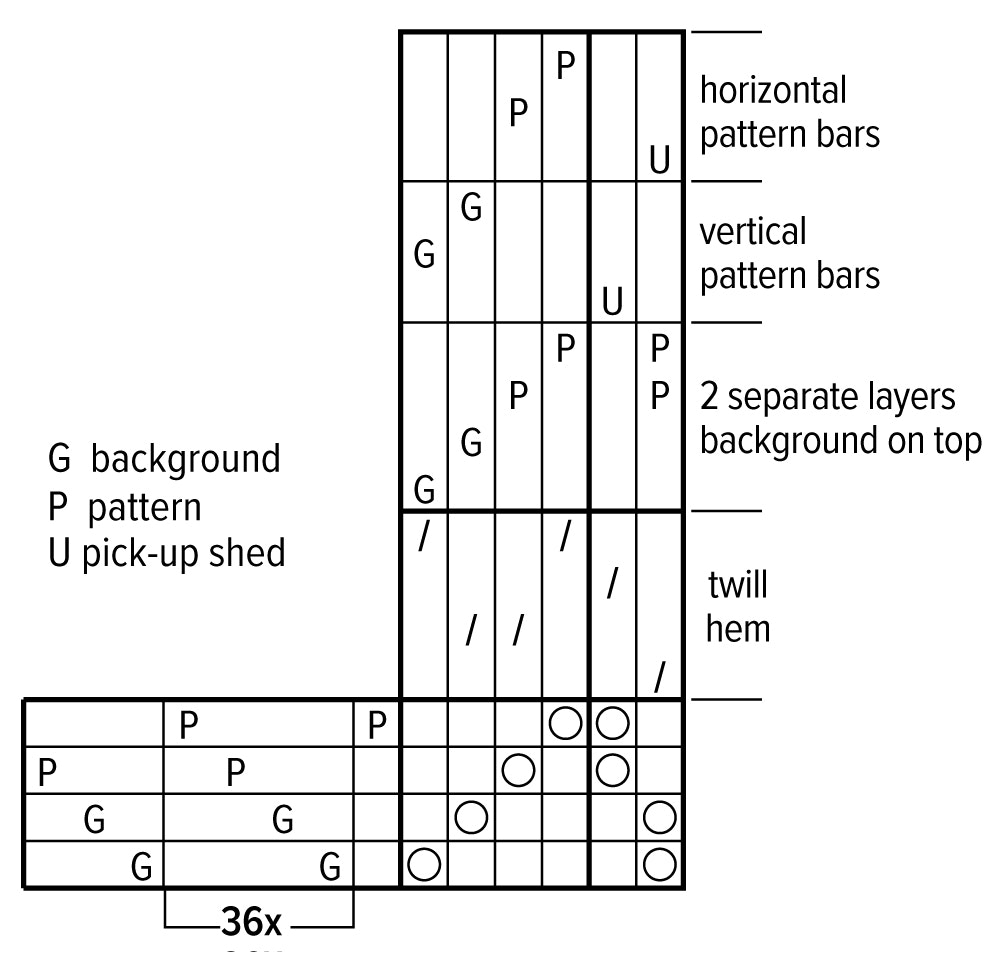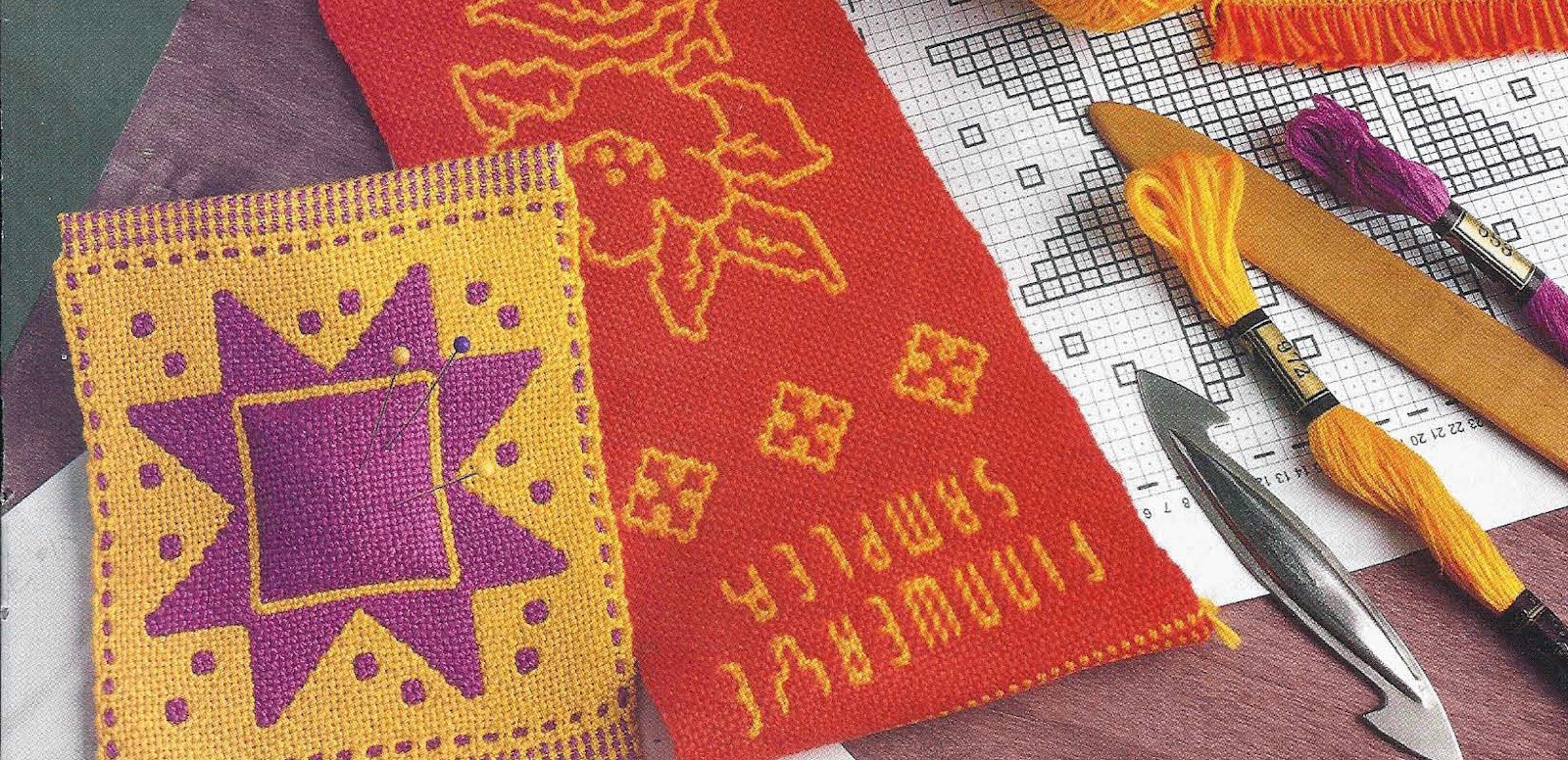Subscriber Exclusive
Fun With Finnweave
Once you get the hang of it, finnweave is quicker to weave than doubleweave pick-up. Give it a try!
Once you get the hang of it, finnweave is quicker to weave than doubleweave pick-up. Give it a try! <a href="https://handwovenmagazine.com/fun-with-finnweave/">Continue reading.</a>
https://handwovenmagazine.com/cdn-cgi/image/format=auto/https://www.datocms-assets.com/75077/1657299772-finnweave-hwjf1999-corrected.jpg?auto=format&w=900
Featured in Handwoven September/October 2022, Claudia Tokola's Finnweave Pillows is a great introductory finnweave project. Current Handwoven subscribers can log in below to access this full article of finnweave instructions and tips by Alison Irwin. You can also find this full article in Handwoven January/February 1999. If you would like to weave the finnweave pin-cushion project and sampler designed by Alison and shown in the header above you can find it in that issue.
Finnweave is a variation of doubleweave pick-up that uses pairs rather than single threads in the warp and weft. It is sometimes called nonreversible doubleweave because the face and back are not mirror images: instead, a continuous line of pattern on the face weaves as a series of dashes on the back.
Compared to doubleweave, Finnweave is quicker to weave because the slim pick-up stick is left in place for two rows of weaving. Visually, Finnweave designs are more fluid; diagonals, much straighter.
Threading and Loom Setup
The ends of the layers alternate two by two in the warp. As in regular doubleweave pick-up, I designate background as G and pattern as P, and I attach a sticky note to my loom to remind myself which is the background color and which the pattern color.
If you are left-handed or if you find it more comfortable to count and use the pick-up stick from left to right, reverse the threading. The tie-up and treadling remain the same.
SUBSCRIBER EXCLUSIVE
Featured in Handwoven September/October 2022, Claudia Tokola's Finnweave Pillows is a great introductory finnweave project. Current Handwoven subscribers can log in below to access this full article of finnweave instructions and tips by Alison Irwin. You can also find this full article in Handwoven January/February 1999. If you would like to weave the finnweave pin-cushion project and sampler designed by Alison and shown in the header above you can find it in that issue.
Finnweave is a variation of doubleweave pick-up that uses pairs rather than single threads in the warp and weft. It is sometimes called nonreversible doubleweave because the face and back are not mirror images: instead, a continuous line of pattern on the face weaves as a series of dashes on the back.
Compared to doubleweave, Finnweave is quicker to weave because the slim pick-up stick is left in place for two rows of weaving. Visually, Finnweave designs are more fluid; diagonals, much straighter.
Threading and Loom Setup
The ends of the layers alternate two by two in the warp. As in regular doubleweave pick-up, I designate background as G and pattern as P, and I attach a sticky note to my loom to remind myself which is the background color and which the pattern color.
If you are left-handed or if you find it more comfortable to count and use the pick-up stick from left to right, reverse the threading. The tie-up and treadling remain the same.
[PAYWALL]
Wind the warp holding both threads together to cut warping time in half. Using a reed that allows you to sley four threads per dent (two background, two pattern) makes it easier to identify pairs when using the pick-up stick.
You'll need six treadles: four tied to the individual shafts, the fifth tied to shafts 1-2, and the sixth tied to shafts 3-4. The background layer is on shafts 1 and 2; the pattern layer is on shafts 3 and 4. One foot controls the pick-up shed, and the other foot opens the shed for the shuttle. As for regular doubleweave pick-up, you'll need graph paper, a fine pick-up stick, shed stick, and shuttles. Modifying the grid on the graph paper by placing a dot in the center of each square makes designing easier. I made mine on the computer using a software drawing program.
Reading a Finnweave Chart
A Finnweave design uses both the grid lines and the spaces of graph paper. Each grid line represents a pair of threads in the background or upper layer of cloth, while each column and row of spaces between the grid lines stand for pairs of threads in the pattern or lower layer. Think of the dot in the center of each square as the intersection of a pair of pattern threads. Without any marks on it, the dotted graph paper represents two separate layers with the background layer on top.

Charting a design is as simple as connecting the dots in the centers of the squares with horizontal or vertical bars-not diagonals. A horizontal bar designates two shots of pattern weft woven on the face of the fabric. A vertical bar stands for a pair of pattern warp ends brought to the face. Horizontal and vertical bars are woven independently of one another. When you flip the fabric over, you will see that horizontal bars have become vertical ones and that vertical bars have become horizontal. They have changed both color and direction. When you become familiar with this layout, you will find it easier to follow the chart than to read the corresponding description.
Weaving Two Separate Layers
Weaving with the background threads on top:
- Lift shaft 1. Throw the background shuttle from the right.
- Lift shaft 2. Throw the background shuttle from the left.
- Lift shafts 1-2-3. Throw the pattern shuttle from the left.
- Lift shafts 1-2-4. Throw the pattern shuttle from the right.
Weaving with the pattern threads on top:
- Lift shafts 1-3-4. Throw the background shuttle from the right.
- Lift shafts 2-3-4. Throw the background sh ut tle from the left.
- Lift shaft 3. Throw the pattern shuttle from the left.
- Lift shaft 4. Throw the pattern shuttle from the right.
Weaving the Design
Start at the bottom of the chart and work up, reading each line and space in turn. Break down each pick-up design into its vertical and horizontal components and weave the bars as outlined below. Finnweave looks better on the face than on the back. Often the face of the cloth has an extra pair of background threads at one edge for balance and to hide the selvedge of the lower layer. Here I've also added a single pattern thread to each side for design purposes. When counting pairs of ends for pick-up, ignore these solitary threads.


Weaving Vertical Bars – Each Bar Crosses a Horizontal Grid Line
- Lift shafts 3-4. Pick up one pair of pattern threads for each bar along the line. Drop shafts 3-4 with the pick-up stick in place.
- Lift shaft l. Move the pick-up stick to the beater. Throw the background shuttle from the right. Beat. Do not remove the pick-up stick.
- Lift shaft 2. Move the pick-up stick to the beater. Throw the background shuttle from the left. Beat. Remove the pick-up stick.

Step 1. Lift the pattern layer and pick up a pair of threads for each vertical bar.

Steps 2 and 3. Lift shaft 1 and throw the background shuttle from the right. Lift shaft 2 ond throw the background shuttle from the left.
Weaving Horizontal Bars – Each Bar Crosses a Vertical Grid Line
- Lift shafts 1-2. Pick up all pairs of the background warp except the ones crossed by bars. Drop shafts 1-2 with the pick-up stick in place.
- Lift shaft 3. Move the pick-up stick to the beater. Throw the pattern shuttle from the left. Beat. Do not remove the pick-up stick.
- Lift shaft 4. Move the pick-upstick to the beater. Throw the pattern shuttle from the right. Beat. Remove the pick-up stick.

Step 1. Lift the background layer and pick up a pair of threads for each line except the ones crossed by a horizontal bar.

Steps 2 and 3. Lift shaft 3 and throw the pattern shuttle from the left. Lift shaft 4 and throw the pattern shuttle from the right.
I love to design Finnweave because linear patterns and letters translate so well. You can write out a favorite saying, or adapt suitable embroidery patterns or quilt blocks. On my sampler, the flower motif, from an Assisi embroidery design normally worked in Holbein stitch, is fabulous in Finnweave.
I found it in Woman’s Day Super Special: 101 Needlework and Sweater Ideas, March 1984 (New York: CBS Magazines).
Now that she’s figured out how to do it, ALISON IRWIN of Duncan, British Columbia, Canada, is fascinated by Finnweave.
Further Reading
Cahlander, Adele, with Suzanne Baizerman. Double-Woven Treasures from Old Peru. St. Paul, Minnesota: Dos Tejedoras, 1985.








